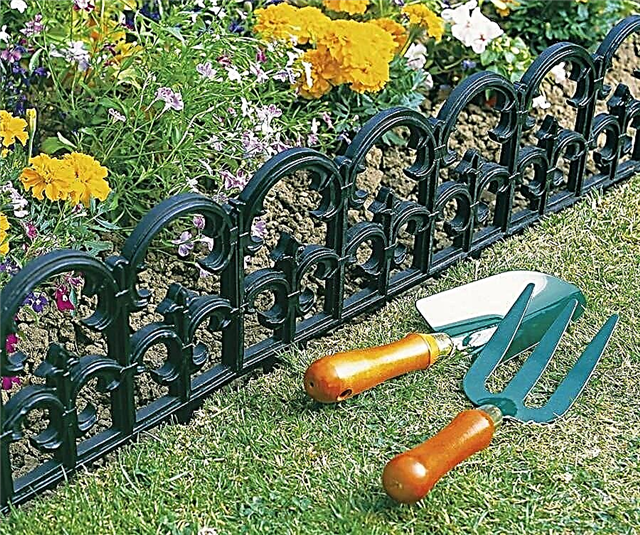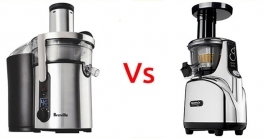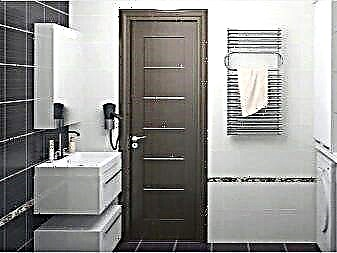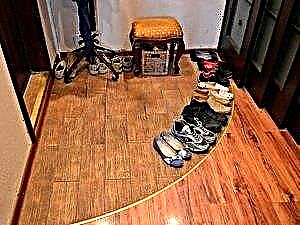 When carrying out repairs, the question often arises, which is better - laminate or linoleum in the apartment? There is no definite answer, since each of the materials has several categories that differ significantly in basic operational characteristics. In addition, the choice is largely determined by the characteristics of the room - attendance, humidity, the need for sanitation, the likelihood of mechanical damage, etc. There is another nuance - some of the properties of floor coverings depend on the installation - the quality of its performance, the use of the substrate, etc.
When carrying out repairs, the question often arises, which is better - laminate or linoleum in the apartment? There is no definite answer, since each of the materials has several categories that differ significantly in basic operational characteristics. In addition, the choice is largely determined by the characteristics of the room - attendance, humidity, the need for sanitation, the likelihood of mechanical damage, etc. There is another nuance - some of the properties of floor coverings depend on the installation - the quality of its performance, the use of the substrate, etc.
Laminate Classes
The class of flooring and its purpose is determined by the strength of the material and the thickness of the upper protective layer.
- 31 class - the least protected and designed for low intensity of operation, characteristic of bedrooms, pantries and other similar rooms. In an apartment or in a house, the service life of such a laminate, depending on the conditions, will be 10-12 years.
- Class 32 laminate can carry an average load, therefore it is quite suitable for home use, where it will last 12-15 years, but for commercial premises it is not advisable to choose such a coating.
- 33rd grade laminate is considered commercial, although it is the least durable in its category. Such coverage can be used in the decoration of gyms, and at home it can be chosen for the most visited rooms (for example, living rooms).
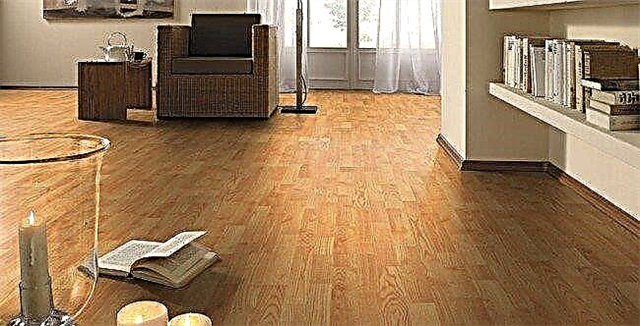 Laminate in the interest of the apartment
Laminate in the interest of the apartment
Appearance
Initially, the laminate was used as a floor covering, visually almost indistinguishable from natural wood. Such models are still popular as attractive in appearance and organically combined with various interior styles. The assortment of the most famous manufacturers usually includes classic and original variations of a laminate under a tree:
- natural (a thin layer of varnish is practically invisible and the coating looks like ordinary wood),
- glossy (in such models, the varnish coating is not only noticeable, but also a characteristic feature, the coating imitates a lacquered wood),
- matte (visually similar to well-proliferated natural parquet),
- aged (the color of such a coating is darker than that of a wood “with experience”),
- textural (similar to rough processing boards),
- waxed (warm and soft shine of boards, characteristic for wooden floors, waxed).
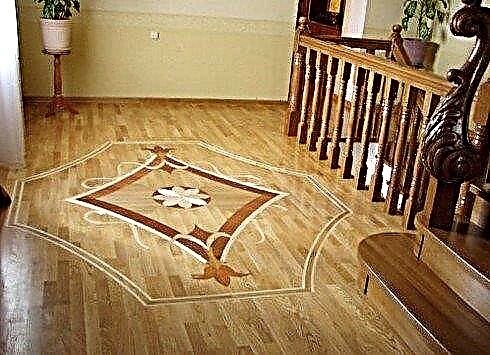 Laminate can also be with a pattern
Laminate can also be with a patternLaminate production technology allows you to create coatings that are completely different from wooden ones; the most original and fashionable ones are laminates in stone and under the skin.
Linoleum
Linoleum is a rolled floor covering, the main advantages of which are moisture resistance and water resistance. Such material not only easily tolerates wet cleaning, including with the use of detergents, but also (subject to proper installation) is able to delay spilled or leaking water in emergency cases in small quantities. When choosing which is better - laminate or linoleum, the expert opinion will be based on a combination of operating characteristics and characteristics of various types of materials.
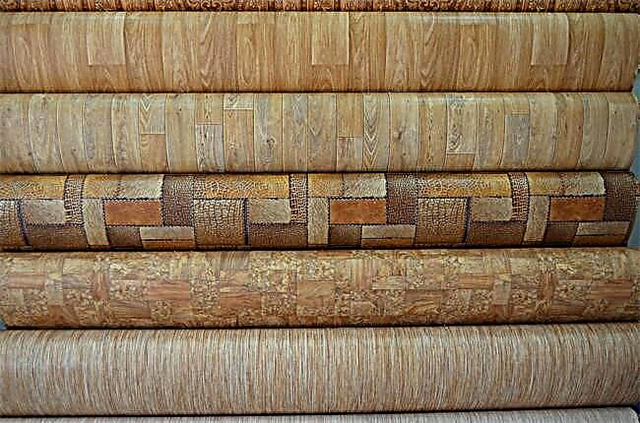 Variants of linoleum drawings are also diverse.
Variants of linoleum drawings are also diverse.
Materials for the manufacture
In many ways, the quality and characteristics of linoleum are determined by its type.
- Natural linoleum is so different from other types in composition, characteristics and price that it is increasingly singled out as a separate category of floor coverings and is called marmoleum. On a jute basis of marmoleum, only natural components are coated - chalk and wood flour, bound with oxidized linseed oil and resins, and the pattern is made using natural dyes. Due to the high price, marmoleum should be excluded from the comparative analysis, the purpose of which is to determine which is better, linoleum or laminate in the house.
- Nitrocellulose coatings are characterized by ductility and high strength with a small thickness. However, nitrocellulose linoleum is not recommended because of its high combustibility.
- Glyphtal linoleum (a special kind of plastic) is produced on a fabric basis and therefore is distinguished by increased heat and sound insulation. During operation, it deforms - stretches in width and “shrinks” in length.
- Linoleum made of rubber is the most moisture-resistant and elastic, so it can easily be laid on an uneven base. At home, it is not used, since it has high toxicity.
- PVC linoleum is the most common type used for commercial premises, rooms in apartments and houses, therefore, in the future, the properties and purpose of this particular type of flooring will be considered. Polyvinyl chloride linoleum may “sit down” a little over time. Such material is produced baseless or on a fabric, foamed, woven basis.
PVC linoleum production technology
According to the manufacturing method, PVC linoleum can be homo- or heterogeneous.
- The choice of colors of heterogeneous linoleum is much larger due to the fact that the coating pattern is exclusively in the upper layer of the multilayer material. This production technology removes almost all the restrictions regarding the choice of gamma and complexity of the picture. Fiberglass as part of heterogeneous linoleum prevents tensile and compressive deformation of the floor covering.
- The pattern of homogeneous linoleum is performed over the entire thickness of the coating, so that it becomes resistant to abrasion. Unlike heterogeneous, homogeneous linoleum can be restored with noticeable surface wear - such coatings are “ground", removing 1 / 20-1 / 5 of the thickness of the coating with a uniform structure. The advantage of homogeneous grades is high strength and durability. Such linoleum not only withstands the steps of people, but also retains its qualities when moving carts and gurneys along it. At the same time, the service life of the coating reaches 25 years or more.
When deciding what is the best choice, laminate or linoleum in the apartment, it should be remembered that the rolled material looks a bit simpler and cannot reliably mimic a tree, even if the corresponding pattern is applied to it.
Classification of linoleum by appointment
Linoleum of various classes differs in strength and wear resistance, however, each category has other nuances.
- The cheapest linoleum is household. Most often it is a multilayer material made of foamed PVC, a decorative layer and a protective coating. In total, the thickness of all layers usually does not exceed 4 mm. The coating has a soft base and does not last very long even with gentle operation.
- The semi-commercial type of coating can be called an improved version of household linoleum. It is more durable and has a greater thickness - from 0.7 cm. The structure of such coatings practically does not differ from household roll material.
- Commercial linoleum is designed for significant loads and is characterized by maximum wear resistance. Due to the fact that this linoleum variety is often used for rooms with high traffic, the surface may have an additional non-slip coating.
- Specialized, manufactured taking into account special requirements determined by the nuances of operation:
- sports with a polyurethane coating,
- for medical institutions with bactericidal components in the surface layer,
- with enhanced sound insulation for music studios, lounges, etc.,
- with a relief on the surface that prevents slipping even when water gets on linoleum.
Insulating qualities
The heat and sound insulation properties of both types of coatings are determined in most cases by the characteristics of the substrate. What is warmer - a laminate or linoleum - largely depends on its material and thickness. It is important to remember that for linoleum the substrate is an addition, the use of which depends on the desire of the owner of the room, and for the laminate it is an indispensable element when laying the coating. Among the various varieties of linoleum, the warmest are those that have a dense fabric or felt base.
 Linoleum with felt base
Linoleum with felt base
Due to its plasticity, linoleum absorbs sounds better, especially for a material with a soft base, while walking on a laminate in shoes with a hard sole or in heels can be heard throughout the apartment. But here again, a quality substrate comes to the aid of the laminate, which serves as an excellent sound insulator.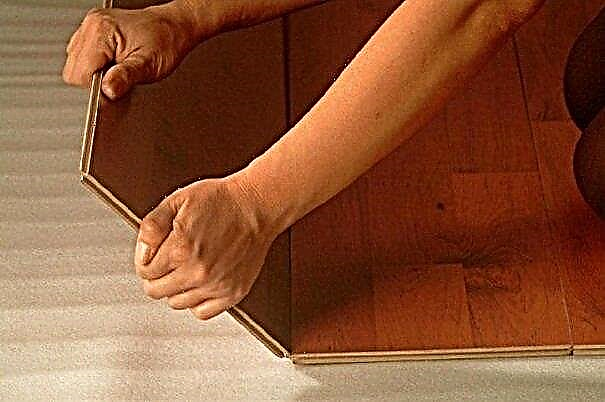
Environmental friendliness
What is more environmentally friendly - laminate or linoleum? Both coatings (taking into account the fact that PVC material is selected from the whole variety of linoleum variants) do not emit toxic substances during operation. When comparing environmental friendliness, the difficulty of utilizing linoleum, which burns with the formation of a pungent odor and the release of harmful substances, is often mentioned. However, given that it is extremely rare for owners of houses and apartments to dispose of the removed coating on their own, this shortcoming can be considered not the most significant.
Transportation
Transporting laminate planks packed in compact blocks is much easier - they can be transported in a personal car and lifted to the floor in an elevator. Linoleum rolls are large (roll width can reach 5 m) and weigh a lot, so for their delivery to the object may require freight transport, and such a roll may not fit in a regular passenger elevator.
Installation and repair
Laying linoleum and laminate is quite simple and to get a high quality coating, it is enough for the home master to follow the instructions accurately, but still assembling the laminate floor requires a more responsible approach. Laying the web material takes less time compared to assembling the coating from the boards, although this will require the use of adhesive or double-sided tape.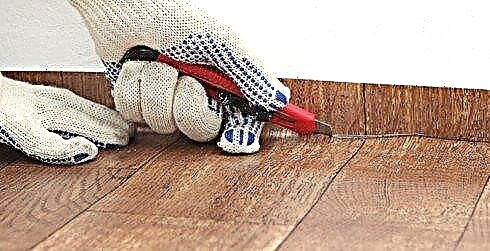
At the same time, for flooring from a laminate flooring should be as even as possible, in connection with which it may require preliminary alignment using special building mixtures.
Laminate is a more maintainable material, if necessary, such a floor can be partially disassembled and some of the boards can be replaced with new ones. Also, small chips and cracks on the panels are perfectly repaired with the help of special repair pastes. Lenoleum cannot be repaired in this way and it is necessary to replace it entirely, and it is more prone to getting scratches and other similar injuries.
Comparison of parameters
For each room, the best choice would be your flooring. In some cases, preference should be given to linoleum, and in others to laminate. At the same time, the variety of both options in terms of strength class, appearance, cost and durability such that the trip to the store is often delayed for several weeks. This dry mix for floor screed is chosen quickly at a time, with a topcoat on top of it, everything is much more complicated.
To determine which option is better laminate or linoleum, it is necessary to compare them by:
- sound insulation
- environmental friendliness
- simplicity with self-installation
- moisture resistance
- operational characteristics
- durability and wear resistance,
- thermal conductivity.
There are many parameters, and all of them must be taken into account when choosing. But first, you should clearly determine - for which particular room the floor covering is selected. For example, for children it is recommended to choose soft linoleum. And in the case of the corridor, the opinion of most owners of private houses usually tends to favor a laminate, which has better wear resistance.
Styling features
It is much easier to roll and spread the rolled material with your own hands than to install laminate lamellas. If in the first case a knife will be enough to cut the coating around the pipes and in the corners of the tools, then in the second case a hacksaw (level saw), a level and a rubber mallet will be required.
The rough basis for both materials is prepared equally. Leveling concrete for screed will have to be carefully for both the laminate and linoleum. Both of them do not tolerate potholes, cracks and debris on a concrete or other other base underneath.
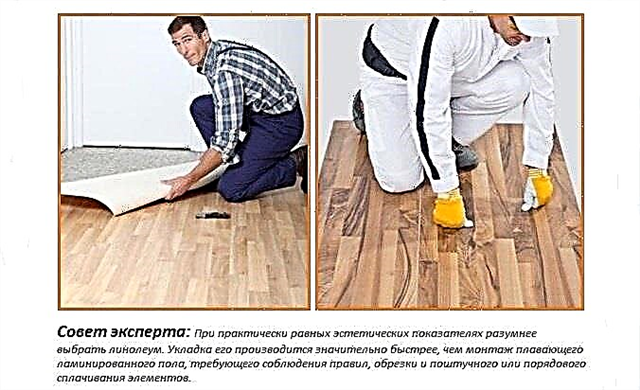
Features laying laminate or linoleum
Moisture resistance and water tightness
Linoleum has better water resistance compared to its competitor. In the first coating there are no castle joints and wood inside, but it is characterized by excellent moisture resistance. The exception is only linoleum materials with felt or fabric backing. If water in large quantities falls under a similar finish on the floor, then it will have to be changed due to the formation of mold in the basis of natural fabric.
Durability and wear resistance
It is difficult to scratch a laminate with furniture legs or shoes. In the corridors and hallways it is best to lay it. Here, the opinions of experts are unanimous - the laminate floor in such rooms will last much longer than linoleum. If the first is able to lie with proper care for 15–20 years, then the service life of the second rarely exceeds 5 years.
However, much will depend on the operating conditions of the floor. Linoleum is easier to push and can even be torn. And the laminate has higher abrasion resistance, but if a pipe breaks, it will swell from the water and warp. It will have to be completely changed, while linoleum coating in such a situation is often enough to just dry thoroughly.

Advantages and disadvantages of laminate and linoleum
Thermal conductivity
When choosing linoleum or laminate to put in the nursery or bedroom, you must remember that the first is warmer to the touch. This is especially noticeable if it has a thick substrate.
The laminated resin layer on the lamellas takes longer to heat up and gives off heat faster. If a water heated floor is installed in the room, then it is worth choosing a laminate coating for it. But in other cases, for rooms where you have to walk barefoot, it is better to prefer soft and warm linoleum.

Features of laying laminate
Best stuff
At a price, the laminate loses to the competitor. Linoleum will be one and a half to two times cheaper per square. However, it is likely to be replaced on the floor sooner. In general, the second option is preferable for living rooms and rooms with high humidity. But for living rooms, hallways and libraries in cottages, it is better to take the first.
Advantages and weaknesses of the laminate
Manufacturers, sellers and authors of materials about laminate flooring on the Internet give a lot of positive characteristics to this type of building materials. True, some of them look incorrect - you can argue about them:
- High strength. This indicator can only be determined by firms from Belgium and Germany. At the same time, in the same class of laminate, the strength range is so large that in the best samples of class 31 it can be higher than that of class 33 laminate. Manufacturers from Russia and China indicate only the class. Therefore, it is impossible to assert unequivocally that the purchased material is durable, you can buy lamellas with very low strength characteristics,
- Long service life.This indicator depends on wear resistance, and, firstly, it is different, and, secondly, with the same value of the indicator, in one case it provides a maximum of 7 years of operation, in the second - more than 20 years. This is explained by the measurement technique,
Conclusion: high strength and wear resistance are inherent only to expensive laminate brands. In the middle price sector, there is complete uncertainty - you can buy both this and that.
- A wide selection of texture, color and size, which allows you to satisfy the most sophisticated tastes. In this case, with a laminate, you can visually change the dimensions of the room: lengthen or expand, highlight individual zones in the room,
- Easy and clear installation technology,
- High resistance to burnout - a special film is applied that does not transmit UV rays,
- The floor from the laminate does not require special care: no need to cycle, varnish or wax. You can clean the dirt with a damp cloth or a paper towel,
- Laminate boards withstand sharp heels, heavy furniture, falling objects, cigarette ash,
- Convenience of transportation
- Excellent abrasion resistance
- Affordable price for a wide mass of buyers.
At the same time, there are several statements that are completely untrue:
- It has good sound absorption - the opposite is true: it resonates and amplifies sounds,
- Keeps heat - cannot be a heater because of a high indicator of thermal conductivity.
Manufacturers and sellers do not like to talk about the shortcomings of the laminate. And they are significant:
- The presence of up to 80% natural wood in the laminate does not guarantee its safety for health. The remaining 20% are phenol-formaldehyde resins that release harmful formaldehyde into the air (the chemical formula of HCNO). This process is especially active when the “warm floor” system is installed,
- One of the main disadvantages is low moisture resistance. From the ingress of water, especially when flooding from above or breaking pipes in the apartment, it swells. This is a complete replacement of the floor and significant financial costs. The same result can be obtained in an apartment on the ground floor if there is a damp basement below, and when waterproofing, the technology for performing work is violated,
- Another significant drawback is that an almost perfect floor screed is needed: smooth, strong, dry and clean, with a height difference of not more than 3 mm per 1 m 2. It’s expensive, long and difficult,
- The ability of a laminate to resonate does not give pleasure either to the neighbors below, or to the owners of the apartment. Properly performed soundproofing work partially solves the problem, but not to the end. Judging by the reviews on the forums, many are trying to get rid of the noise with a thicker substrate. But this is a variant of the “trishkin caftan”, when, solving one problem, they create several new ones - on the thick substrate, the lamella locks very quickly break
- The laminate protective film accumulates static voltage from a working personal computer. These are unpleasant sensations when walking and accumulating dust,
- Spilled grease, ink and oil paint are difficult to remove, and therefore experienced professionals do not recommend laying it in the kitchen and in the children's room,
- The floor from the laminate after wet cleaning is very slippery, which is almost never mentioned, but traumatologists are well aware of the problem,
- The surface of the floor feels cold, which is especially unpleasant in the autumn-winter period,
- The slightest non-compliance with the installation technology can lead to deformation of the laid floor with sharp temperature fluctuations,
- Special care is required when installing furniture. Hit of two legs on one panel will inevitably lead to the destruction of the lock.
Decorative design
In appearance, the laminate is as close as possible to natural wood. The varieties of the laminate organically fit into any style of interior and look very attractive in appearance. In addition to the classic variations, modern manufacturers offer original solutions with imitation of natural wood: natural coating (with the thinnest lacquer layer, maximally approximating the appearance of the laminate to natural wood), glossy models (with imitation of lacquered wood), matte (visually reminiscent of proliferated natural parquet), aged coatings, textured patterns (resembling rough boards), waxed solutions (boards with a warm and soft shine, resembling waxed floors). Often, decorative patterns are additionally applied to laminated boards.
Modern technologies allow us to produce a completely non-standard laminate. For example, imitating skin or stone.
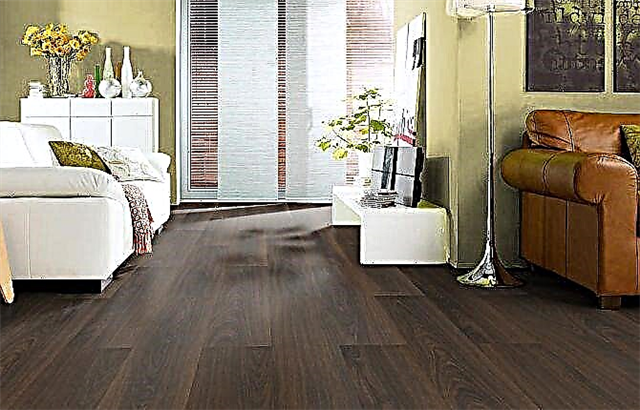
Materials used
The characteristics of linoleum are largely determined by its belonging to one or another type. Natural material has fundamental differences from other solutions in terms of composition, characteristics and price. Manufacturers separate it into a separate category of floor coverings and assign the name of marmoleum.
Marmoleum has a jute base, on which layers of wood flour and chalk are applied. Resins and oxidized linseed oil act as a link between them. To apply the drawing, appropriate natural dyes are used. Marmoleum can not compete with other types of coverage due to the high cost.
Linoleum based on nitrocellulose is more common. Among its advantages can be identified increased ductility, low thickness and high strength. Linoleum has a high tendency to burning, so it is not recommended for interior decoration.

Linoleum made of special plastic - griftal - has a fabric base underneath. Its distinguishing features are high heat and sound insulation characteristics. With prolonged use, linoleum experiences strain. It extends in width and becomes shorter in length.
Rubber linoleum is the undisputed leader in terms of elasticity and resistance to moisture. This allows you to lay the canvas on the base with minor irregularities without any special difficulties. Toxicity inhibits the use of this material in a residential environment.
In homes and offices actively use PVC-based linoleum. It can be completely devoid of base or available on a special substrate made of fabric, felt or foamed PVC.
Varieties of linoleum
Belonging to a particular class of linoleum determines its strength characteristics, wear resistance and other parameters.
Household linoleum remains the most budgetary solution. Most often it is represented by a multilayer material based on foamed PVC. Additionally, in the linoleum there is a decorative layer and a special protective coating. The total thickness of the layers rarely exceeds 4 mm. The linoleum base is quite soft and is characterized by a short service life.
Semi-commercial linoleum is an improved prototype of household linoleum. Its strength characteristics are higher, and the thickness reaches 7mm.
Commercial type linoleum is designed for rooms with high traffic and has maximum wear resistance. For most models, the surface has an additional anti-slip coating to prevent injuries during operation. The question is what is better to lay: a laminate or linoleum, is solved for a particular room.
Specialized linoleum is made according to the specific requirements of the room. There are sports coatings with a polyurethane base, medical linoleums with a bactericidal surface layer. No less popular solutions for music studios with increased sound insulation. The surface of the material can be embossed to prevent slipping even on wet surfaces.
Insulating properties
Sound and heat insulation largely depends on the used substrate material and its thickness parameter. The use of a substrate for linoleum is an additional measure, for a laminate, the presence of a substrate is a prerequisite. The warmest is linoleum with a fabric or felt base. Felt base contributes to more efficient absorption of sounds. If you move around the laminate in hard shoes or high heels, then sounds, on the contrary, will spread throughout the apartment. The problem can be partially solved by using a quality substrate.
The choice of material for the floor
The cost of these types of coatings in almost the same price segment. However, the appearance of the laminate is much prettier than linoleum. Buyers often doubt the durability of the laminate.

Choose a laminate or linoleum - which is better to choose. To begin, consider the structure of both materials
Linoleum is usually biased. He is considered a relic of the past, a “scoop”, material much worse than a laminate, this is absolutely not an objective attitude! If your choice fell on linoleum, do not be guided by your emotions, approach the matter with reason, there are times that this type of coating is most successful.
Features of linoleum
The official name of linoleum, which we often see in the store, is “PVC coating”. Real linoleum is an expensive floor covering. It contains linseed oil, wood flour and resin, jute fabric, limestone powder, etc. This coating is hard to find in an ordinary, hardware store.
The flooring in kindergartens, educational institutions, polyclinics, office premises is a 100% PVC coating.
PVC coating - This is absolutely artificial material. The people called him “Linoleum”, after which they were given the same name in the factories of building materials.
Nowadays, linoleum consists of six layers:
- Wrong.
- Foamed bottom layer.
- The supporting layer is glass canvas.
- Top foam layer.
- Drawing, decorative layer.
- A transparent layer that protects linoleum from damage.
Comparing natural real linoleum and artificial linoleum is wrong. These two materials are completely different, because by linoleum, in most cases, we mean synthetic PVC coating.

PVC linoleum has three types:
- Commercial linoleum. It is the densest, it is usually used in such rooms where there is a lot of people attendance. Such linoleum can be found in schools, state medical institutions, shops, as well as in various other public places. On such a linoleum conceived, a special coating is applied so that there is no slipping and accidents. The advantage of this coating is that it is resistant and safe.
- Household linoleum. Use it exclusively in residential premises. This material is not as reliable and durable as a commercial lineleum. But this linoleum has the advantage, with it you can not restrain your imagination! What colors are not presented in stores - bright colors, riot of color, imitation of parquet, boards, bricks, tiles and others.
- Semi-commercial linoleum. It is a cross between domestic and commercial. Semi-commercial linoleum has medium strength, service life. It can be used everywhere: both at home (apartment), and in various other commercial public buildings. Semi-commercial linoleum is not suitable for storage facilities, factory floors.
The main advantages of linoleum
- Low price segment, affordable for any customer.
- A large palette of colors, shades, drawings. You can choose linoleum for any interior.
- To lay linoleum, you do not need to be a specialist. If you have strong hands, you will be able to handle it yourself.
- Floors that are covered with linoleum are rarely cold. This material has a low thermal conductivity.
- Linoleum does not deteriorate; it is made from synthetic materials.
- No noise from heels will bother you - such floors provide little noise insulation. Therefore, in this case, linoleum is better than a laminate.
- Linoleum often has anti-slip coating.
- Even if you didn’t get anti-slip on your linoleum, it is very difficult to fall on it, it is not slippery.
- The service life of linoleum is huge! Just imagine, having laid linoleum, you can not think about the state of the floor for the next 25-60 years.

The disadvantages of PVC coating (linoleum)
- Today it is very fashionable to use environmentally friendly materials, but linoleum is not.
- Compared to the beauty of the wood floor.
- Linoleum wrinkles under the weight of furniture. Your sofa is guaranteed to leave dents, and it’s not very convenient if you plan to relocate
- Not expensive linoleum is rarely resistant to temperature changes. At high, it is deformed, and at low, it cracks.
- Often, linoleum looks cheap. But today, the manufacturer offers us interesting drawings - an imitation of any gender, whether it is wooden or tile.
- Linoleum is easy to cut and scratch. If pets live in your house, they will certainly leave their marks on the floor.
If you choose high-quality, modern linoleum, then it will not differ at all from a laminate. Most people have all the negative attitude to linoleum "in the head", and nothing is not justified. Try different options for using linoleum in your home, believe me, your attitude will change dramatically, in a good way.
Features of using a laminate
The laminate structure consists of:
- Substrate. It protects the laminate from possible deformation, gives the material rigidity.
- The main layer of HDF. It is in it that a castle is cut that will hold the boards together.
- A decorative paper that gives the laminate a color.
- The upper polymer layer (acrylic, melamine resin), which the coating protects from external, mechanical influences. This layer may not be one. In this case, the quality of the floor will increase.
Laminate has various wear classes. And already depending on the class of wear resistance of the laminate, you can choose a laminate for a certain room, whether it is residential or public.
The household class of the laminate has the number 21, 22, 23. Commercial - 31, 32, 33. The difference in them is the degree of load that the coating can withstand.
Laminate of 21 classes is usually chosen for the bedroom, 22 classes are usually laid in the children's room or living room, 23 classes for the hallway and kitchen. Use 32 class in the office, 31 class in the conference room. Class 33 laminate, which is designed for the largest loads, can be used in a store, cafe, sports hall.
Unfortunately, in Russia, the production of laminate 21, 22, 23 classes is not established. Due to this nuance, you have to purchase this coating at times more expensive.
But in Europe, laminate flooring is used to decorate cheap hotels and offices that are rented out.

At home, due to the durability of the coating, it will be appropriate to use the laminate in the hallway. There is a special laminate for the kitchen. It has moisture resistant properties, special impregnation is applied on top.
If you do not know what is better than a laminate or linoleum in terms of the choice of pattern and color, then you should know that in design solutions the laminate is not inferior to linoleum. It is made with imitation of a wide variety of materials and wood species. The top layer of the laminate is matte, glossy, or structural.
Cons and disadvantages of laminate flooring
- If your room is humid and you have not used a moisture-resistant laminate, then the floor will last relatively short. 5 years maximum. Therefore, it is better not to use the laminate in wet rooms, it will be several times worse than linoleum.
- Laminate is inferior to natural wood.
- If a heavy object falls on your floor from the laminate, it is possible that damage will remain.
- If you often wash the laminate, then it will not remain beautiful white spots.
- When dust and water get into the seams between the masonry, the edge of the laminate spoils. Paul begins to creak.
- If you are flooded with neighbors, then most likely, the laminate will have to be changed. He is afraid of moisture! Therefore, in this case, linoleum is better than a laminate.
- An unexpected fact about laminate flooring - this material attracts dust due to its static nature. Sometimes, he can even electric shock! There are special antistatic agents that do not solve this problem much.
As you can see, both types of flooring have disadvantages and advantages.
What unites them?
The similarities between laminate and linoleum
- Available at a price.
- Both are not inferior to each other in beauty.
- Both have no burnout properties.
- Both are not environmentally friendly materials.
- Both coatings are from a cheap segment of materials, not prestigious.
- Relatively stable.
- Easy to install, do not require professional skills.

How to choose a floor covering for a specific room
It is better to lay a laminate in the bedroom, living room and hall. It is less toxic and more stylish. Its relief is pleasant to the feet.
It is better to lay linoleum in the kitchen if there is no plan to change the floor every 3 to 5 years. However, this is a matter of taste and your financial capabilities.
For the office also, it is best to choose linoleum. Laminate quickly loses its appearance and begins to creak if you choose it for a passage room. Every businessman knows that a beautiful office is the image of the company. Laminate is very noisy, and the sound of heels can distract employees from work, reducing company performance. For example, in American offices, carpeting is often used for floors. In our country, this is practically not possible (due to dirty streets).
Floor on the balcony - which one to choose?
If you need to make a floor on a balcony or a loggia, and you are faced with a dilemma, it is better linoleum or a laminate, then better choose the first option. Laminate does not tolerate rain, it will deteriorate if you do not close the glazed window. Linoleum is warmer for the legs. The only negative in this case is that it can deteriorate from crackling frost.

What is better to choose on the floor to the balcony or loggia. It is desirable to choose linoleum, as it is moisture resistant and less susceptible to temperature changes. Perhaps the best option would be tile.
We hope that we helped you in the right choice, you need to choose building material with a special approach. It is better not to regret the time and money for choosing building materials on the floor, so that later you do not regret the money spent and the time lost. Do not save on quality, because the avaricious pays twice. It’s better to pay more once, but to make really high-quality and beautiful floors that can last for decades. Feel free to go to the store using the knowledge gained from this article.
Pros and cons of linoleum
A large number of fans of linoleum due to its many advantages:
- Having a democratic price (cheap), it is available to almost every family - the most expensive type can afford a family with an income below the average,
- Long term operation - in the “odnushki” of the Khrushchev building could serve 20-30 years,
- Easy to install - the most simple installation technology among all types of flooring, so any "nerd" can lay it,
- Easy care - just a mop and rags, with strong contamination, detergents will help,
- Can be laid on the "warm floor"
- Absolute resistance to moisture, if immersed in water for several days, the material will retain all its consumer properties,
- High level of adhesion - it’s difficult to slide on it, therefore it is spread in gyms and public places,
- It is a good insulation - the lower layer of felt or foamed PVC have a low thermal conductivity,
- No noise - the quietest flooring
- Large selection of designs and colors - any design idea can be put into practice.
It is difficult to find building material without flaws. There are also disadvantages to linoleum:
- Operating characteristics change with temperature fluctuations: it becomes slippery and goes a wave at subzero temperatures, begins to release substances harmful to health (ceases to be environmentally friendly) and shrinks at high (over 27 degrees Celsius). Low-grade material becomes brittle, prone to deformation in frost in the country,
For reference: linoleum refers to chemical materials, therefore it behaves under the influence of temperatures in an unusual way: it expands where other materials are compressed, and shrinks where it expands.
- Constant specific odor in the heat outside
- Inconvenient during transportation - you need freight transport and manual transportation, since the rolls do not fit in the elevator,
- It melts on contact with hot objects, including cigarette ash,
- Damaged (there are traces that cannot be removed) when moving furniture,
Important: in Soviet times, the last drawback was avoided with the help of skins from fat - put under the legs and moved. This method made it much easier to move objects without traces.
- Visible seam, under which dirt constantly accumulates - attempts to glue the joint with tape or special materials do not give a lasting effect: they begin to peel off,
- Sensitive to chemicals
- Requires an even floor screed
- Black footprints are difficult to clean,
- Material of any class will necessarily shrink, as a result of which the connecting seam will open in 3-4 years and begin to hurt your eyes. Therefore, the joints must be hidden near the walls or use material 5 m wide.
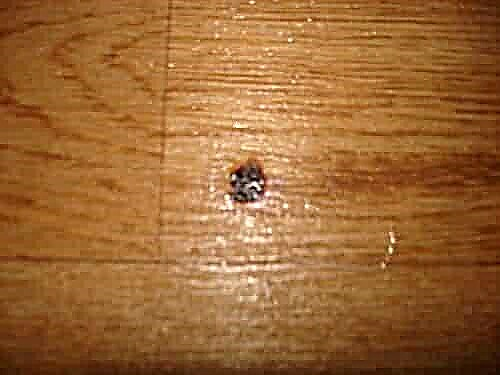
As you can see, when determining which is better - linoleum or laminate, the pros and cons considered do not make it possible to make an unambiguous choice in favor of one of the types of flooring. Therefore, we will conduct a direct comparison of materials for all technical, technological and economic indicators.
Comparative analysis of linoleum and laminate boards
To understand which is better, linoleum or laminate flooring in an apartment, we compare the floor coverings and draw conclusions on the following characteristics:
- price of 1 m 2 of material,
- the cost of laying 1 m 2,
- the complexity of the installation process,
- floor screed surface requirements,
- the ability to disassemble (dismantle),
- life time,
- fire safety
- wear resistance
- resistance to UV rays (burnout),
- resistance to static loads,
- resistance to dynamic loads,
- resistance to mechanical damage,
- water resistant
- thermal conductivity,
- soundproof properties
- environmental friendliness
- ease of care
- which gets dirty faster
- use under the "warm floor" system,
- design.
What is cheaper
One of the main criteria for choosing a floor is its price. Therefore, it is initially necessary to decide what is cheaper - a laminate or linoleum in an apartment. If we take budget building materials, then linoleum is about 2 times cheaper than laminate - the price of linoleum starts at 120 rubles / m 2, laminate boards - from 260 rubles / m 2.
In the premium class, the run-up is even greater - 2.3 times: linoleum can be bought for 360-600 rubles / m 2, laminate - for 840-1400 rubles / m 2. Conclusion: in this comparison, linoleum has an obvious advantage.
What is cheaper to stack
In addition to the price of the material itself, the cost of laying the floor has a significant impact on the owners wallet. To install the laminate in a direct way, you can hire a team of builders for 250-400 rubles / m 2, plus 150 rubles / m 2 for laying waterproofing and substrates. Linoleum flooring will cost from 90 rubles / m 2.
Conclusion: laminate flooring is expensive, so linoleum has an advantage. However, when doing the work on their own, the materials have almost parity - to lay the lamellas you need a tool that you must either buy or rent.
What is more difficult to lay
Flooring in both cases is quite simple - even a beginner can cope with work. However, the complexity of the work and its complexity still makes a difference - for laying the laminate, you will need a good knowledge of the technology, attentiveness, the ability to work with tools and significantly more time for the whole process. Conclusion: an indicator in favor of linoleum, although with a slight advantage.
Which material has easier floor screed requirements?
Linoleum and laminate require an equally flat surface of the base on which they will be laid. Any irregularities affect the surface of the material - linoleum is wiped in such places, locks are destroyed at the laminate.
The influence of tubercles up to 3 mm high on the floor covering is eliminated by a laminate substrate, felt or PVC film from linoleum (glued from the bottom of the material). With large differences in height, it is necessary to carry out additional leveling of the screed. Conclusion: the materials are completely equal.
What is more durable
According to the operating periods declared by the manufacturers, both materials have an approximate parity of 10-15 years. However, it is easier to damage linoleum during operation: scratches from sharp objects, melted spots from an iron or ash from cigarettes, traces of furniture and black rubber soles.
Linoleum can break through with a strong punch, keep a trace of a blow for a long time, etc. These reasons dramatically reduce its life. Laminate is not so afraid of dynamic and static loads, it is not afraid of sharp objects - it is difficult to scratch it. Conclusion: for the first time at a laminate, although small, but the advantage is that it is more practical.

What material burns worse
Linoleum is made from chemical components. Therefore, his ability to burn is much higher. This is also reminded by the inscriptions on the package, where the combustibility class is indicated by the letter “G” (combustibility) and numbers from 1 to 4 (class). Another problem: when burning linoleum, toxic substances are released, which is reminded of the classifiers designated T1-T4 (increasing).
Laminate does not support open flame - smolders. However, he also emits harmful substances, however, in insignificant amounts. All this served as the basis for laminate manufacturers not to indicate combustibility and toxicity classes for their products. Conclusion: in terms of fire safety, the laminate has undoubted leadership.
Which material has higher wear resistance
According to this indicator, the materials are approximately equal - in residential premises it is impossible to wipe while walking. Under the influence of abrasive materials, they also quickly become unusable - there are traces that cannot be removed. Conclusion: the indicator can be ignored - none of the materials have advantages.
What burns out less
There is no rigid binding to a specific type of material. Everything is determined by the absence or presence of a special film (by the way, that is, whether it is on the surface of the material or not, it does not affect the price), which protects the decorative layer from ultraviolet radiation. It is difficult to independently determine the presence of a protective film. Therefore, ask consultants or room managers. Conclusion: the materials are completely equal.
What is stronger
Here, materials are immediately comparable in three indicators: resistance to static and dynamic loads, as well as to mechanical damage. For all three characteristics, the undoubted leader is the laminate. It is important here to prevent two or more legs from falling onto the same laminate board when installing furniture - the locks will be destroyed.
Linoleum can withstand heavy furniture, but footprints remain almost until the end of their life. Sharp objects remain scratches that cannot be removed. With prolonged use in one place of an office chair with legs, attrition appears on linoleum. Conclusion: the laminate is definitely stronger.
Which material has higher moisture resistance?
There is no need to go into details: linoleum can withstand not only accidentally spilled water, but also a real flood. Laminate is hygroscopic - the weather is damp enough for it to deteriorate. Conclusion: if we are talking about a room with high humidity or frequent flooding, then only linoleum is needed here.
Which is warmer
Here, contrary to popular belief, linoleum leads. Thin chemical material conducts heat worse than a thicker laminate based on wood fibers. The situation is leveled by thermal insulation of the floor under the laminate. Conclusion: linoleum retains heat better, although, as noted on the forums, it is colder in tactile sensations.
Which is quieter
Laminate is a very good resonator. Almost everything that happens in the apartment is heard from below neighbors. This floor also interferes with the residents themselves - the sounds scatter well into the rooms. Carrying out perfectly executed soundproofing works solves the problem of 90 percent. For example, the clatter of thin heels cannot be drowned out under any efforts.
Linoleum not only absorbs all kinds of extraneous noise well, but also does not conduct apartment sounds to walls and ceilings. He is the most silent floor. Conclusion: linoleum is the undisputed leader in noise absorption.
What is more harmful
On the issue of harm to health from the analyzed materials, the situation is a bit confusing. Under optimal operating conditions, each material is environmentally friendly, and so much so that a small child can play on the laminate and linoleum without any health consequences. When the temperature regime deviates from the optimum, for example, in the direction of increasing, both of them start to release harmful substances into the air. But this, we emphasize, under force majeure circumstances.
Conclusion: despite the chemical components that make up the materials, they are both safe for human health.
Which is easier to wash
Caring for both types of material is very easy. If necessary, detergents can be used. The only limitation: the laminate needs to be washed with a wrung rag. Yes, black footprints on shoes on linoleum are well cleaned with a cotton swab dipped in acetone. Conclusion: here is complete equality.
What gets dirty faster
Due to the accumulation of static electricity, the laminate is polluted faster. But this minus, oddly enough, has its own plus: less dust on the walls, shelves, fixtures and various decorative elements, which is much easier to wipe from the floor than from the items listed above. Conclusion: paradoxically, experts give the advantage on this issue to the laminate, although it becomes more polluted faster.
What is more beautiful
The diverse design of the laminate and linoleum has led to the fact that it is often visually difficult to determine the type of flooring. Various colors, textures, drawings allow you to implement the most unexpected decisions on the device of the floor when decorating the interior of the room and the apartment as a whole. Conclusion: both materials do not create problems for the designer.

In conclusion of the topic, which is better, laminate or linoleum, we give the expert opinion: linoleum is more of a kitchen type of floor, although it can lie in any room of the apartment, while it is less desirable in the bedroom and the nursery due to a slightly noticeable smell. In addition, it is ideal for a loggia and a balcony. Laminate was conceived and produced for residential premises - it has a more presentable appearance. It is undesirable in the kitchen and unacceptable in the bathroom.
What is better and in which room
Before considering the issue of what is better and in which room, we will understand two private issues.
- In new buildings on the ground floor you always need to lay linoleum. While the house is not in operation, it is difficult to predict what the basement will be: wet or dry. Only during floor replacement can a laminate be laid. If damp comes from the basement, you will have to do double waterproofing: under the screed and on top of it.
- A similar situation in a private house. Until there is clarity on the humidity under each room, linoleum should lie on the floor.
Attention: in practice, there are frequent cases of violation of water exchange at the construction site when pouring the foundation, as a result of which, on a dry site, unexpectedly high humidity appears under the building.
Returning to the main question, we note that in living room preferably laminate. This is explained by the status of the premises: the central place in the apartment (house), where guests gather for the holidays, get-togethers are arranged. It is here that it is possible and necessary to demonstrate the level of well-being and taste of the owners, which is possible by a presentable laminate.
IN the bedroom it is also better to lay the panels of the laminate. They are odorless, look beautiful, do not collect dirt - there are no static charges. IN hallway and in the corridor linoleum is better - dirt from the street is easier to wash away. However, the presence of rugs on both sides of the door allows the laminate to be successfully used in these rooms.
On the the kitchen and in bath linoleum looks more functional - increased humidity and constant water on the floor is not for the laminate. On the balcony There is no alternative to linoleum - regular soaking in the rain eliminates the option of laminate flooring, and any of the materials in question can be used in the loggia.
Conclusion
When comparing materials for each position, conclusions were drawn. We summarize them and give them in a concentrated form. In terms of money, linoleum is a very profitable version of the floor - it has the price of the material and the installation cost several times lower than that of the laminate.
The laminate is more reliable in strength: it withstands higher static and dynamic loads. It is difficult to damage it with thin heels, hot and sharp objects. If you choose a better material, then it is difficult to give preference to someone. Both materials have approximately the same life, both look equally beautiful. Both types of material are not hazardous to human health.

